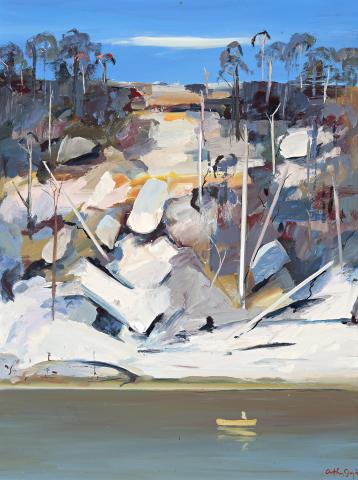SHOALHAVEN; HILLSIDE WITH ROCKS AND MAN IN BOAT
ARTHUR BOYD
oil on composition board
122.0 x 91.0 cm
signed lower right: Arthur Boyd
Wagner Art Gallery, Sydney
Sotheby's, Melbourne, 26 November 2001, lot 21
Company collection, Sydney
Private collection, New South Wales
In the early 1970’s, as Arthur and Yvonne Boyd looked towards returning to Australia to live, they fell in love with the Shoalhaven River on the New South Wales south coast. They bought one, and then a second adjoining property with the intended result of preserving a large area of natural bushland for generations to come. This represented a symbolic reclaiming of his homeland following the redevelopment in Victoria of the land which had been home to the Boyd’s for generations. On the Shoalhaven River Boyd immersed himself in the landscape and created a body of work which reflected not only his relationship with the Australian landscape, but importantly the artists who depicted it.
Perhaps the clearest influence in Boyd’s Shoalhaven work is that of Tom Roberts. The manner in which Boyd depicts the rocky hillsides, with their midday shadows tucked tightly beneath the rocks, is distinctly reminiscent of Tom Roberts’ New England paintings of the 1890’s. Writing in The Artist and The River, Sandra McGrath describes his influences more broadly...
'While Boyd in general chooses to portray the Shoalhaven landscape more identified with Von Guerard and Buvelot, at other times he cannot resist the temptation to paint the landscape in the manner of the early Box Hill painters ... Despite their reliance on a realistic approach to the subject, the Boyd Shoalhaven landscapes are more varied in technique and style than one might suppose. With his prodigious ability the artist is able to take the nature of the subject and render it in a manner which captures the essence of its particular properties at that time, or imbue it with a sense of character and meaning which is the result of his own immediate emotional or psychological response.'1
In Shoalhaven; Hillside with Rocks and Man in a Boat, it is the brittle midday light which dominates the painting as the landscape towers over the figure and boat. The rocky hillside evokes a majestic permanence while the boatman, perhaps drifting for flathead, suggests mankind’s transient journey and the fickle nature of his presence next to nature. Here Boyd uses scale to great effect, but it is the harsh light and the drama that conspire to press Boyd’s ideas about our place in the landscape.
The painted surface In Shoalhaven; Hillside with Rocks and Man in a Boat is both fluid and precise as Boyd flaunts his virtuosity with an artist’s most direct and expressive tool - paint. By the time Boyd reached the Shoalhaven, decades of working with paint had equipped the artist with the technical dexterity of a jazz musician; he simply played along or innovated as he felt.
His most nuanced painting implement was his bare hands, which he used beautifully when he felt the need to convey compassion. Whether that was painting creatures like fish, dogs, the human figure, or in this case the rugged landscape of the Shoalhaven River.
1. McGrath, S., The Artist and The River: Arthur Boyd and The Shoalhaven, Bay Books, Sydney, 1982, p. 63
HENRY MULHOLLAND
